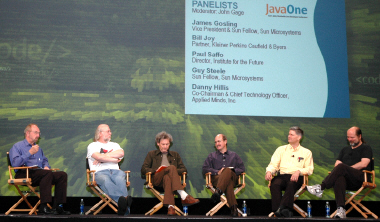Views from the smartest people in Sun's orbit

A JavaOne panel with some of the smartest people orbiting Sun provided some insight into where Java, porgramming models, Google and man-machine relationships are heading. Guy Steele, a Sun Fellow and a key participant in Java's creation, talked about his latest language project, Fortress, which he described as "doing for Fortran what Java did for C." Steele said that Java isn't ideal for numerical computing and the mathematical community, such as chemists and physicists. And, Fortan was invented on keypunch card systems. Fortress, which was funded in part by DARPA, brings mathematical and programming notation closer together. In addition, Steele said that Fortress is build with parallelism in mind, which is increasingly important as chasing after clock speed for performance is replaced by multicore processors.
The April specification describes Fortress as follows:
The name "Fortress" is derived from the intent to produce a "secure Fortran", i.e., a language for high-performance computation that provides abstraction and type safety on par with modern programming language principles. Despite this etymology, the language is a new language with little relation to Fortran other than its intended domain of application. No attempt has been made to support backward compatibility with existing versions of Fortran; indeed, many new language features were invented during the design of Fortress. The result is a language that employs cutting-edge features from the programming-language research community to achieve an unprecedented combination of performance and productivity.
Steele also said that he is experimenting with designing a framework for language designers, making rich and complex code libraries, and then presenting a much simpler programming model for developers or even non-programmers. Java father James Gosling piped in that Sun's tools are moving in that direction. Sun chief researcher John Gage told the audience of several thousand that they must all read Steele's 1998 paper, "Growing a Language."

From left: John Gage, Sun chief researcher; James Gosling, Sun Fellow, Bill Joy, former Sun Fellow and now a partner at Kleiner Perkins Caufield & Byers; Paul Saffo, director of the Institute for the Future; Guy Steele, Sun Fellow; and Danny Hillis, co-chairman and CTO of Applied Minds.
Gosling and other panelists discussed how computation, and the network, are a fabric that is driving all kinds of interesting things at the edge, not just in the electronic sense but also in a physical sense. "We humans have become part of an ether of computation," said tech wizard Danny Hillis. "If you are in a conversation and you don’t know something, you go do Google to search....it's augmenting in a clumsy way. We will get more intimate --when you want a question answered, just think of it and some process will go out on Net and answer will appear to you." Hillis claimed, "I can't think properly unless I am connect," to which Paul Saffo quipped, "that's due to middle age."
Connection for Hillis, as well as Sun, means computing power available like electricity. Hillis discussed how his company is working with Cedars Sinai Medical Center to take information from a drop of blood--which has more data than the entire human genome project--and making it useful, such as analyzing treatment and response and then applying the data to treat others. Taking terabytes of data from a blood drop and moving it around a hospital network to make sense of it requires a different order magnitude of computation, Hillis said. "The only way to make it work is the utility model of computing, generator at Niagra Falls....you can apply teraflops of computing as long as you need to get answers."
Bill Joy, one of the founders of Sun and Java, noted that that databases are too slow. "If you organize information around a transaction data structure in memory of a powerful machine, you can do hundried times more transactions," Joy said. "It will allow new set of applications. Multiplayer games, for example, have a large transactional space and are more pioneering the enterprises today."
Saffo warned that predictions about the future are not very reliable. "The future always arrives late and in really peculiar ways," he said. But Saffo agreed with Hillis and Gosling that the edge is the new center. "Now cyberspace is learning lots about the physical world. In ten years cyberspace will overlay the physical world."
Saffo extrapolated that to keep growing and continue the massive cash flow, Google will have to index the physical world. He imagined Google sending out robot dogs (Googlebots) to take pictures of everything in his office. "I won't have any more privacy, but at least Ill know where to go when I lose my car keys," Saffo said. Imagine Google Earth getting down to 30 centimeter resolution.
Saffo told the audience that if they want to be the next Bill Gates or Steve Jobs, think robots. He cited the robotic vacuum cleaner Roomba as an early indicator. "Seventy percent of people give their robots a name--how many ever gave their vacuum cleaner a name?," Saffo said. "Thirty percent confess to having taken Roomba on vacation or over to friends' houses. "There's huge pent up demand for pieces of electronics that roll around, companions that do something useful."
The discussion turned briefly to biotech. "The most powerful shifts will occur when people start hacking the bio code," Gage said. Joy believes that Moore's Law has about ten years left, and that applying concepts, such as how proteins catalyze and interact, will be applied to electronics.